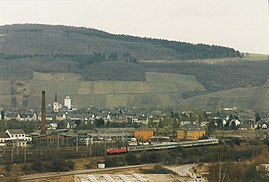Ehrang train station
| Honor | |
|---|---|
 former marshalling yard
|
|
| Data | |
| Location in the network | Separation station |
| Platform tracks | 4 (3 regularly used) |
| abbreviation | SEG |
| IBNR | 8000370 |
| Price range | 5 |
| opening | March 25, 1871 |
| Profile on Bahnhof.de | Honor |
| Architectural data | |
| Architectural style | Historicism / Art Nouveau |
| architect | Julius Carl Raschdorff |
| location | |
| City / municipality | trier |
| Place / district | Honor |
| country | Rhineland-Palatinate |
| Country | Germany |
| Coordinates | 49 ° 48 '7 " N , 6 ° 41' 8" E |
| Railway lines | |
|
|
| Railway stations in Rhineland-Palatinate | |
The station Ehrang is after the Trier main station of the second most important station of the Rhineland-Palatinate town of Trier . The station forms a railway junction with a former marshalling yard , which is still partially used as a freight yard today. In it, the Eifel route in the direction of Cologne separates from the Moselle route in the direction of Koblenz . Until 1983, the Ehranger train station was also the starting point for the Trier western line to Igel and on to Wasserbillig / Luxembourg .
history
Ehranger Bahnhof was opened in 1870 as a station for the Rheinische Eisenbahngesellschaft . Together with the opening of the railway line from Trier to Gerolstein , general traffic began here on March 25, 1871 and the Trier western line , built since 1860, was completed with this section. The station building of Ehrang resembled those along the route; each a small castle . This happened because France had to pay a large sum of war debts to Germany after the war of 1870/1871 . It was expected that it would take many years to pay off this debt. But the whole debt was paid off in one single payment. Now the empire could afford to build these (train station) castles. The design for the planning of the building in Ehrang comes from the famous master builder Julius Carl Raschdorff , who also designed the Kyllburg and Speicher stations.
As part of the strategic “ cannon railway ” from Berlin to Metz in what is now France , the railway line from Koblenz along the Moselle to Trier was built between 1874 and 1879 , making Ehrang station a small junction.
The station building is still largely in its original state, even if it is no longer owned by Deutsche Bahn .
Reception building
The reception building including the outbuildings and the water tower are designated as a cultural monument according to the Rhineland-Palatinate Monument Protection Act (DSchG) .
The water tower is a spherical water tank riveted to a conical base made of cast iron plates, which was built between 1907 and 1913. Today the water tower is a relatively rare representative of the water towers often built around 1900 according to the Intze system.
The ensemble of reception building, shed and servant house is a picturesque group building with red sandstone facades.
The entire ensemble has the address Ehranger Straße 2, 3, 4, 5, 7 and 8 .
traffic
The tariff of the Verkehrsverbund Region Trier (VRT) applies to all local public transport in Ehrang and the tariff of Deutsche Bahn AG (DB) applies to the rail routes .
Rail transport
In rail transport the station Ehrang is served by the following lines:
| line | designation | Line course | Clock frequency |
|---|---|---|---|
| RB 22 | Eifel Express |
Cologne Fair / Deutz - Cologne - Euskirchen - Jünkerath - Gerolstein - Bitburg-Erdorf - Ehrang - Trier
(Cologne Fair / Deutz - Gerolstein as RE 22) |
60 min
(in the HVZ repeater trains to Gerolstein / Jünkerath) |
| RB 81 | Moselle Valley Railway | Koblenz - Cochem - Bullay (DB) - Wittlich - Ehrang - Trier | 60 min |
| RB 83 | Wittlich - Ehrang - Trier - Wasserbillig - Sandweiler-Contern - Luxembourg | 60 min
(Wittlich - Trier only Mon-Sat) |
The next long-distance connections are in Koblenz Hbf , Saarbrücken Hbf and Luxembourg .
Bus transport
literature
- List of monuments of the Directorate General for Cultural Heritage, Rhineland-Palatinate, 2010
- Father Josef Böffgen: Well town Gerolstein old and new pictures. European Library, 1978
- Manfred Stoos, Bitburg-Erdorf, 2010
Web links
- Track plan of Ehrang station , DB Netz AG (PDF)
Individual evidence
- ↑ abbreviation
- ↑ Query of the course book route 690 at Deutsche Bahn.
- ↑ Query of course book route 474 at Deutsche Bahn.
- ↑ Father Josef Böffgen: Well town Gerolstein old and new pictures. European Library, 1978
- ^ Manfred Stoos, Bitburg-Erdorf, 2010
- ↑ General Directorate for Cultural Heritage Rhineland-Palatinate (ed.): Informational directory of cultural monuments in the district-free city of Trier (PDF; 1.2 MB). Koblenz 2010
- ↑ List of monuments of the General Directorate for Cultural Heritage, Rhineland-Palatinate, 2010




